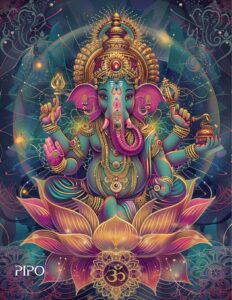
oṃ madanāgamasattantrapāragāya namo namaḥ oṃ
ॐ मदनागमसत्तन्त्रपारगाय नमो नमः ॐ
Salutations to the one who has overcome all desires – conjugal, material and spiritual and has mastery over everything that’s inner and outer.
HE has overcome all desires, has no conjugal desires or material pursuits, nor any spiritual needs to acquire. HE is the embodiment of everything that’s inner and outer to the beings and materials.
This verse offers salutations to the divine entity as the ultimate transcendent being—one who has surpassed all desires and dualities, both material and spiritual. It recognizes the divine as the embodiment of mastery and completeness, beyond all forms of longing or dependency.
Deeper Insights
- Mastery Over Desires
The term Madanāgama refers to desires, including those linked to physical attraction (Madana). The verse emphasizes that the divine is beyond such worldly attachments. By conquering all conjugal, material, and even spiritual desires, the divine exemplifies ultimate detachment (vairāgya). This transcendence symbolizes a state of perfection, where the divine is free from all limitations imposed by desires or needs. - Beyond Material and Spiritual Aspirations
While material pursuits bind most beings to the world, even spiritual aspirations can become a form of attachment. This verse highlights that the divine is not bound by the need for liberation, knowledge, or ascetic practices. Instead, the divine is the source and culmination of all spiritual paths, rendering personal striving unnecessary. - Inner and Outer Embodiment
The phrase inner and outer signifies the completeness of the divine presence. The divine is both immanent (antar)—pervading the inner self, and transcendent (bahir)—existing beyond all material forms. This duality reflects the divine’s role as the ultimate reality, encompassing all dimensions of existence. - Supreme Sovereignty
The term sattantrapāragāya suggests mastery over the tantras (cosmic systems, practices, or mechanisms governing existence). The divine is not only beyond these systems but also the controller of them, emphasizing a state of supreme sovereignty over all inner and outer realms.
Symbolic Implications
- Freedom from Bondage:
This verse inspires aspirants to rise above the layers of desires that bind them to the cycle of birth and rebirth. It serves as a reminder that true liberation comes from transcending not just material needs but also the subtle attachments of the mind and ego. - Path to Oneness:
By saluting the one who embodies everything inner and outer, this verse reminds us of the interconnected nature of existence. The ultimate goal is to see the divine not as separate from us but as the essence within and around us.
Practical Reflection
For seekers, this verse provides a guiding principle: to aspire for a life where desires no longer dictate actions and where inner mastery leads to alignment with the divine will. Meditating on this verse helps foster detachment, contentment, and a deeper understanding of one’s inner nature.
Concluding Thoughts
This verse exalts the divine as the perfect embodiment of transcendence and mastery. It invites us to reflect on the ultimate goal of life: to rise above desires, see beyond dualities, and realize the unity of the inner and outer worlds within the divine essence. Salutations to this unparalleled state of perfection and peace.
Discover more from Dr Pallavi Kwatra
Subscribe to get the latest posts sent to your email.

